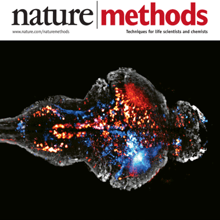Filter
Associated Lab
- Remove Ahrens Lab filter Ahrens Lab
- Aso Lab (1) Apply Aso Lab filter
- Branson Lab (1) Apply Branson Lab filter
- Fitzgerald Lab (1) Apply Fitzgerald Lab filter
- Freeman Lab (5) Apply Freeman Lab filter
- Harris Lab (2) Apply Harris Lab filter
- Jayaraman Lab (2) Apply Jayaraman Lab filter
- Johnson Lab (1) Apply Johnson Lab filter
- Keller Lab (5) Apply Keller Lab filter
- Lavis Lab (2) Apply Lavis Lab filter
- Liu (Zhe) Lab (1) Apply Liu (Zhe) Lab filter
- Looger Lab (7) Apply Looger Lab filter
- Pedram Lab (1) Apply Pedram Lab filter
- Podgorski Lab (3) Apply Podgorski Lab filter
- Schreiter Lab (4) Apply Schreiter Lab filter
- Shroff Lab (1) Apply Shroff Lab filter
- Svoboda Lab (4) Apply Svoboda Lab filter
- Turaga Lab (2) Apply Turaga Lab filter
- Turner Lab (2) Apply Turner Lab filter
- Wang (Shaohe) Lab (1) Apply Wang (Shaohe) Lab filter
- Zlatic Lab (1) Apply Zlatic Lab filter
Associated Project Team
Associated Support Team
Publication Date
- 2024 (5) Apply 2024 filter
- 2023 (4) Apply 2023 filter
- 2022 (4) Apply 2022 filter
- 2021 (2) Apply 2021 filter
- 2020 (4) Apply 2020 filter
- 2019 (5) Apply 2019 filter
- 2018 (4) Apply 2018 filter
- 2017 (2) Apply 2017 filter
- 2016 (7) Apply 2016 filter
- 2015 (3) Apply 2015 filter
- 2014 (3) Apply 2014 filter
- 2013 (2) Apply 2013 filter
45 Janelia Publications
Showing 41-45 of 45 resultsThe nature of nervous system function and development is inherently global, since all components eventually influence one another. Networks communicate through dense synaptic, electric, and modulatory connections and develop through concurrent growth and interlinking of their neurons, processes, glia, and blood vessels. These factors drive the development of techniques capable of imaging neural signaling, anatomy, and developmental processes at ever-larger scales. Here, we discuss the nature of questions benefitting from large-scale imaging techniques and introduce recent applications. We focus on emerging light-sheet microscopy approaches, which are well suited for live imaging of large systems with high spatiotemporal resolution and over long periods of time. We also discuss computational methods suitable for extracting biological information from the resulting system-level image data sets. Together with new tools for reporting and manipulating neuronal activity and gene expression, these techniques promise new insights into the large-scale function and development of neural systems.
Motor systems must continuously adapt their output to maintain a desired trajectory. While the spinal circuits underlying rhythmic locomotion are well described, little is known about how the network modulates its output strength. A major challenge has been the difficulty of recording from spinal neurons during behavior. Here, we use voltage imaging to map the membrane potential of large populations of glutamatergic neurons throughout the spinal cord of the larval zebrafish during fictive swimming in a virtual environment. We characterized a previously undescribed subpopulation of tonic-spiking ventral V3 neurons whose spike rate correlated with swimming strength and bout length. Optogenetic activation of V3 neurons led to stronger swimming and longer bouts but did not affect tail beat frequency. Genetic ablation of V3 neurons led to reduced locomotor adaptation. The power of voltage imaging allowed us to identify V3 neurons as a critical driver of locomotor adaptation in zebrafish.
Motor systems must continuously adapt their output to maintain a desired trajectory. While the spinal circuits underlying rhythmic locomotion are well described, little is known about how the network modulates its output strength. A major challenge has been the difficulty of recording from spinal neurons during behavior. Here, we use voltage imaging to map the membrane potential of large populations of glutamatergic neurons throughout the spinal cord of the larval zebrafish during fictive swimming in a virtual environment. We characterized a previously undescribed subpopulation of tonic-spiking ventral V3 neurons whose spike rate correlated with swimming strength and bout length. Optogenetic activation of V3 neurons led to stronger swimming and longer bouts but did not affect tail beat frequency. Genetic ablation of V3 neurons led to reduced locomotor adaptation. The power of voltage imaging allowed us to identify V3 neurons as a critical driver of locomotor adaptation in zebrafish.
Brain function relies on communication between large populations of neurons across multiple brain areas, a full understanding of which would require knowledge of the time-varying activity of all neurons in the central nervous system. Here we use light-sheet microscopy to record activity, reported through the genetically encoded calcium indicator GCaMP5G, from the entire volume of the brain of the larval zebrafish in vivo at 0.8 Hz, capturing more than 80% of all neurons at single-cell resolution. Demonstrating how this technique can be used to reveal functionally defined circuits across the brain, we identify two populations of neurons with correlated activity patterns. One circuit consists of hindbrain neurons functionally coupled to spinal cord neuropil. The other consists of an anatomically symmetric population in the anterior hindbrain, with activity in the left and right halves oscillating in antiphase, on a timescale of 20 s, and coupled to equally slow oscillations in the inferior olive.
Brains are notoriously hard to understand, and neuroscientists need all the tools they can get their hands on to have a realistic shot at it. Advances in machine learning are proving instrumental, illustrated by their recent use to shed light on navigational strategies implemented by zebrafish brains.


